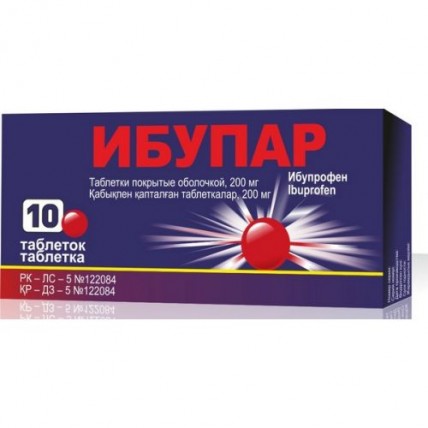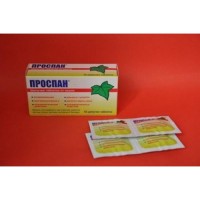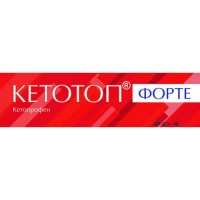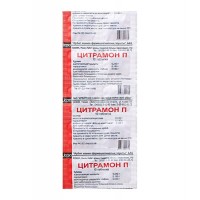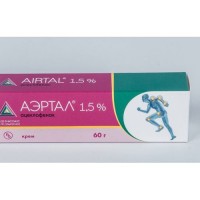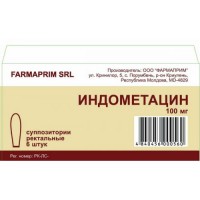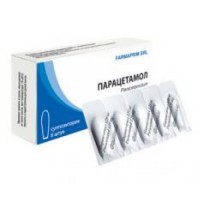Ibupar 10s 200 mg coated tablets
- $5.10
The instruction for medical use of Ibupar Torgovoye medicine a name Ibupar Mezhdunarodnoye the unlicensed name Ibuprofen Dosage Form of the Tablet, coated, 200 mg Structure One tablet contains active agent – an ibuprofen of 200 mg, excipients: potato starch, lactoses monohydrate, povidone (25), silicon dioxide colloidal, talc, magnesium stearate. sugar cover: sucrose, talc, gum Arabian, koshenilovy red (E124), wax of karnaubskiya, wax white. The description of the Tablet of round shape, red color, with a biconvex smooth surface, from 11.5 to 12.5 mm long. Pharmacotherapeutic group Anti-inflammatory and antirheumatic drugs. Non-steroidal anti-inflammatory drugs. Propionic acid derivatives. Ibuprofen. ATH M01AE01 code Pharmacological Pharmacokinetics Absorption properties. The ibuprofen is soaked up from digestive tract approximately for 80%. Concentration of medicine increases linearly, together with a dose. The maximum concentration of an ibuprofen in serum is reached in 1 - 2 hour after reception on an empty stomach. Food and antiacid medicines do not reduce absorption of an ibuprofen. The ibuprofen for more than 99% contacts proteins of plasma, generally albumine. Distribution. The volume of distribution of an ibuprofen is from 0.12 l/kg to 0.2 l/kg. The ibuprofen slowly gets into a joint cavity and therefore in rheumatism its action is completely shown only in several hours after reception. It is necessary to pay attention to it, when choosing a dosage of drug, and at assessment of treatment outcome. Biotransformation. The ibuprofen biotransformirutsya in a liver up to 2 metabolites. Removal. Drug is removed generally by kidneys in the form of inactive metabolites. The entered ibuprofen dose completely is removed within 24 hours. The insignificant quantity of an ibuprofen is removed with a stake. Elimination half-life in serum makes about 2 hours. The pharmacodynamics Ibupar is the non-steroidal anti-inflammatory drug rendering weak – moderate analgetic action and febrifugal action. The mechanism of anti-inflammatory and febrifugal action is based on oppression of synthesis of prostaglandins, also existence of other mechanisms is not excluded. Analgeziruyushchy action of an ibuprofen can depend also, besides, on oppression of a lipoxygenase responsible for synthesis of the leukotrienes which are considered as mediators of pain reaction. Are possible as well other mechanisms of analgeziruyushchy action. The ibuprofen has also ability of reversible slowing down of aggregation of thrombocytes. Anti-inflammatory action of an ibuprofen leads to decrease in symptomatic manifestations of rheumatic diseases. Oppression of synthesis of prostaglandins reduces sokratitelny ability of a uterus and also, such undesirable action of an ibuprofen as damage mucous a stomach, a retention of liquids, bronkhospastichesky reactions and other. Indications - migraine, a dorsodynia, a toothache, neuralgia, painful periods, rheumatic and muscular pain - a headache, relief of symptoms of flu and catarrhal diseases, decrease in temperature the Route of administration and doses Only for oral introduction and short-term use. Dosage: The initial dose makes from 200 mg to 400 mg once or from 200 mg to 400 mg each 4 – 6 hours, as required. The daily dose should not exceed for adult 1200 mg. Elderly people: in case function of a liver and (or) kidneys is not broken, change of dosing is not required. In case of a renal failure and (or) a liver the dose should be selected individually. It is necessary to inform the patient that in need of medicine use more than 3 days or in case the condition of the patient worsens, he has to see a doctor. Medicine should be accepted in time or after a meal. Tablets should not be halved. For the purpose of minimization of risks of development of undesirable reactions, the drug should be taken in a minimal effective dose and throughout minimum short period necessary for achievement of clinical effect. Side effects Side effects are grouped according to approach frequency, beginning from the most often noted: very often (≥ 1/10), it is frequent (from ≥ 1/100 to & lt, 1/10), infrequently (from ≥ 1/1000 to & lt, 1/100), is rare (from ≥ 1/10,000 to & lt, 1/1000), is very rare (& lt, 1/10,000). Infrequently: - nonspecific allergic reactions and anaphylactic reactions, reactions from airways (bronchial asthma, including its aggravation, a bronchospasm, an asthma, dispnoe), skin reactions (itching, urticaria, a Quincke's edema, an exfoliative and bullous dermatosis, a toxic epidermal necrolysis, Stephens-Johnson's syndrome, a mnogoformny erythema), allergic rhinitis, an eosinophilia - dyspepsia, an abdominal pain, nausea, pains in the field of epigastrium, spastic an abdominal cavity pains - discomfort in the field of epigastrium, heartburn - a headache - scotomas, illegibility of sight, a diplopia, disorder of color sight - urticaria, an itching, an alopecia - a symptom a complex with abdominal pain, fever, a fever, nausea and vomiting - dryness of a mucous membrane of an oral cavity, an ulceration of gums, rhinitis. Seldom: - diarrhea, a meteorism, a constipation, vomiting, gastritis - dizzinesses, an insomnia or drowsiness, excitement, nervousness and feeling of fatigue. Very seldom: - a tar-like chair, vomiting with blood impurity, a stomacace, exacerbation of colitis and Crohn's disease. There can be a peptic ulcer of a stomach and (or) duodenum, perforation, bleeding from digestive tract, sometimes from the death, especially elderly people have an aseptic meningitis, consciousness disorder - a depression, emotional lability - sonitus, a hearing disorder - an azotemia, a hamaturia, a renal failure, including an acute renal failure, a necrotic papillitis, reduction of clearance of creatinine, a polyuria, an oliguria, increase in concentration of sodium in serum (sodium retention) - abnormal liver functions, positive takes of functional hepatic trials, especially at prolonged use, hepatitis, jaundice - an agranulocytosis, aplastic anemia, hemolytic anemia sometimes with positive reaction of Koombs, an eosinophilia, a leukopenia, a neutropenia, thrombocytopenia with a purpura or without it, decrease in level of hemoglobin or a hematocrit - acute reactions of hypersensitivity, such as: edema of face, language, throat, suffocation, arterial hypotension, tachycardia or sharp shock, bronkhospastichesky reactions, exacerbation of asthma, bronchospasm. Often: - a dieback, including spotty and papular forms - a loss of appetite. During use of medicines from the NPVS group in high doses the development of hypostases, hypertensia and heart failure is noted. Especially long reception and in high doses (2400 mg a day), can be connected with insignificant increase in risk of arterial embolisms (for example, a myocardial infarction or a stroke) Contraindications - hypersensitivity to an ibuprofen or any excipient - a peptic ulcer of a stomach and (or) duodenum in a phase of aggravation or in the anamnesis, the perforation or bleeding including coming later uses of NPVS - a heavy liver failure, a heavy renal failure or heavy heart failure - existence in the anamnesis of symptoms of an allergy in the form of rhinitis, urticaria or the bronchial asthma connected with intake of acetylsalicylic acid or other non-steroidal anti-inflammatory drugs - the third trimester of pregnancy and the period of a lactation - children's and teenage age up to 18 years - hereditary intolerance of fructose, deficiency of Lapp-lactoses enzyme, glucose galactose malabsorption Medicinal interactions the Ibuprofen (also as well as other medicines from the NPVS group) it is not necessary to accept along with following medicines: - acetylsalicylic acid or other non-steroidal anti-inflammatory drugs: the risk of side effects - antihypertensive drugs (APF inhibitors and antagonists of angiotensin II) and diuretics increases: NPVP can reduce efficiency of drugs of these groups. Diuretics and APF inhibitors can increase nephrotoxicity of NPVP - diuretics: there are not numerous proofs of decrease in efficiency of diuretics - antitrombotichesky drugs: not numerous clinical trials indicate strengthening of effect of the drugs reducing blood clotting, NPVS can increase effect of such anticoagulative drugs as atsenokumarol - lithium and a methotrexate: it is proved that non-steroidal anti-inflammatory drugs can increase concentration in plasma, both lithium, and a methotrexate, it is recommended to carry out control of level of lithium and a methotrexate in serum - a zidovudine: there are proofs about increase in a bleeding time at the patients who are at the same time accepting an ibuprofen and a zidovudine - corticosteroids: simultaneous use of NPVS and corticosteroids can increase risk of development of undesirable effects, especially from digestive tract - cardiac glycosides: NPVS can strengthen heart failure and increase concentration of cardiac glycosides in plasma - mifepristone: NPVS should not be applied within 8-12 days after intake of mifepristone as NPVS can reduce its efficiency - cyclosporine: simultaneous use of NPVS and cyclosporine increases risk of nephrotoxic action - takrolimusy: at co-administration of NPVP and takrolimus the increase in risk of nephrotoxicity - hinolonovy antibiotics is possible: simultaneous use of NPVS with hinolonovy antibiotics increases risk of appearance of spasms. Special instructions It is recommended to take the drug the greatest possible short course and in the minimal effective dose necessary for elimination of symptoms. The means suppressing cyclooxygenase and synthesis of prostaglandins can influence an ovulation, breaking women's reproductive function (it is reversible after treatment cancellation). During long-term treatment the control of a picture of peripheral blood and a functional condition of a liver and kidneys is necessary. At emergence of symptoms of a gastropathy the careful control including carrying out an ezofagogastroduodenoskopiya, the general blood test (hemoglobin definition), the analysis a calla on the occult blood is shown. In need of definition of 17 ketosteroids, drug should be cancelled in 48 hours prior to a research. During treatment the intake of ethanol is not recommended. At treatment of chronicities and at prolonged use the emergence of other side reactions is possible. The first symptoms of such disturbances are fever, a sore throat, superficial ulcers in an oral cavity, a grippopodobny syndrome, the significant weakness, bleedings from a nose and hypodermic hemorrhages, bleedings and bruises of an unknown etiology. With care in the presence of the states specified in this section before use of drug it is necessary to consult with the doctor: - heavy somatopathies, dislipidemiya / a lipidemia, diabetes, diseases of peripheral arteries, smoking, frequent alcohol intake, simultaneous use of medicines which can increase risk of developing of ulcers or bleeding, in particular, oral glucocorticosteroids (including Prednisolonum), anticoagulants (including warfarin), selective serotonin reuptake inhibitors (including a tsitaloprama, fluoxetine, a paroksetin, sertraline) or antiagregant (including acetylsalicylic acid, klopidogret), pregnancy the I-II trimester, the breastfeeding period, advanced age. Respiratory organs: development of a bronchospasm in patients, with bronchial asthma or allergic diseases in a stage of aggravation or in the anamnesis is possible. A system lupus erythematosus or the mixed disease of connective tissue (Sharp's syndrome): the risk of aseptic meningitis the Renal failure is increased, including in dehydration (clearance of creatinine less than 30-60 ml/min.), a nephrotic syndrome can be aggravated. Hepatic dysfunction (a liver failure, cirrhosis with portal hypertensia, a hyperbilirubinemia) can be aggravated. Arterial hypertension and/or heart failure, cerebrovascular diseases: the liquid delay, a hypertension, hypostases are possible. Diseases of blood of not clear etiology (leukopenia and anemia): can be aggravated. Disturbance of reproductive function of women: there are limited data as regards the means suppressing cyclooxygenase and synthesis of prostaglandins can influence an ovulation, breaking women's reproductive function. Such action is reversible after treatment cancellation. Digestive Tract (DT): NPVP should appoint with care to patients with gastrointestinal diseases in the anamnesis (nonspecific ulcer colitis, Crohn's disease) as these states can be aggravated. Existence in the anamnesis of a single episode of a peptic ulcer of a stomach or GIT of bleeding, gastritis, enteritis, colitis, presence of an infection of Helicobacter pylori, ulcer colitis belongs to risk factors. Gastrointestinal bleeding, an ulcer or perforation of a wall of a GIT in the presence of the burdened anamnesis, can develop without the warning symptoms and in certain cases can be deadly. The risk of gastrointestinal bleedings, ulcers or perforation of a wall of a GIT and the unsuccessful outcome connected with development of these states is higher at patients of advanced age, especially at reception of a high dose of NPVP. These patients have to receive treatment by a short course in a minimal effective dose. Patients with gastrointestinal diseases in the anamnesis, have to report about any again appeared abdominal symptoms (especially gastrointestinal bleeding) which develop at the initial stages of treatment more often. This medicine contains 14 mg of potassium on a dose. It needs to be taken into account to patients with need of control of level of potassium for blood. Use at pregnancy and during breastfeeding Despite the fact that, any teratogenic effects was not shown in in vivo experiments, use of an ibuprofen of 200 mg in capsules it is necessary to avoid within the first 6 months of pregnancy. In the III trimester the ibuprofen is contraindicated as there is a risk of premature closing of an arterial channel of a fruit with possible persistent pulmonary hypertensia. The beginning of childbirth can be detained, and duration of action is increased, possible the increased tendency to bleedings both at mother, and at the child. There are data that the ibuprofen in insignificant quantities can get into breast milk without any negative consequences for health of the baby. Features of influence on ability to run vehicles, mechanisms. The patients noting dizziness, drowsiness, block or disorders of vision at reception of an ibuprofen should avoid driving of motor transport or control of moving mechanisms. Overdose Symptoms. At most of the patients accepting medicines from the NPLS group in doses is higher than recommended, such symptoms as nausea, vomiting, pain in epigastriums can appear or are more rare – diarrhea. Sonitus, a headache, dizziness and bleeding from a stomach and intestines can be also noted. Heavy intoxication influences the central nervous system and is shown by drowsiness and also, very seldom, excitement and a disorientation or a coma. Very seldom attacks of spasms can be noted. During heavy intoxication there can come the metabolic acidosis, and the prothrombin time can increase. The acute renal failure or injury of a liver, an apnoea, sudden falling of arterial blood pressure, bradycardia or tachycardia and atrial fibrillation can develop. At patients with bronchial asthma there can occur aggravation of symptoms of a disease. Treatment. Gastric lavage, intake of activated carbon. The symptomatic and supporting treatment is performed. It is necessary to control the vital functions. In case of frequent or long attacks of spasms the intravenous administration of diazepam or lorazepam is necessary. In case of patients with bronchial and
tmy administration of broncholitic medicines is necessary. Considering considerable linking of medicine with blood proteins, the hemodialysis is not effective. There is no specific antidote. The form of release and packing On 10 tablets place in blister strip packaging from a film of polyvinylchloride and aluminum foil. On 1 planimetric packing together with the instruction for use in the state and Russian languages put in a cardboard pack. To Store storage conditions at a temperature not over 25 of 0C to Store out of children's reach! A period of storage 3 years not to apply after an expiration date Prescription status Without prescription Pharmaceutical Works Polfa in Pabianice Joint Stock Company Producer. 5, marsz. J. Piłsudskiego Str., 95-200 Pabianice, Poland Owner of the registration certificate of Adamed Consumer Healthcare S.A. Pienkow 149, 09-152, Czosnow, Poland Applicant of Adamed Consumer Healthcare S.A. Pienkow 149, 09-152, Czosnow, Poland the Address of the organization accepting in the territory of the Republic of Kazakhstan a claim (offer) from consumers on quality of medicine and responsible for post-registration observation of safety of medicine Representative office of JSC Pabianice Pharmaceutical Plant Polfa in RK, 050029, Almaty, Bogenbay Street of the batyr, house 150, business center "Kadam Invest", floor 9. Phone number: +7 (727) 2776977. E-mail:
To Develop info.kz@adamed.com.pl
tmy administration of broncholitic medicines is necessary. Considering considerable linking of medicine with blood proteins, the hemodialysis is not effective. There is no specific antidote. The form of release and packing On 10 tablets place in blister strip packaging from a film of polyvinylchloride and aluminum foil. On 1 planimetric packing together with the instruction for use in the state and Russian languages put in a cardboard pack. To Store storage conditions at a temperature not over 25 of 0C to Store out of children's reach! A period of storage 3 years not to apply after an expiration date Prescription status Without prescription Pharmaceutical Works Polfa in Pabianice Joint Stock Company Producer. 5, marsz. J. Piłsudskiego Str., 95-200 Pabianice, Poland Owner of the registration certificate of Adamed Consumer Healthcare S.A. Pienkow 149, 09-152, Czosnow, Poland Applicant of Adamed Consumer Healthcare S.A. Pienkow 149, 09-152, Czosnow, Poland the Address of the organization accepting in the territory of the Republic of Kazakhstan a claim (offer) from consumers on quality of medicine and responsible for post-registration observation of safety of medicine Representative office of JSC Pabianice Pharmaceutical Plant Polfa in RK, 050029, Almaty, Bogenbay Street of the batyr, house 150, business center "Kadam Invest", floor 9. Phone number: +7 (727) 2776977. E-mail:
To Develop info.kz@adamed.com.pl
